C.M. Rosens's Blog, page 35
October 25, 2021
Bonus Episode: Overexposure
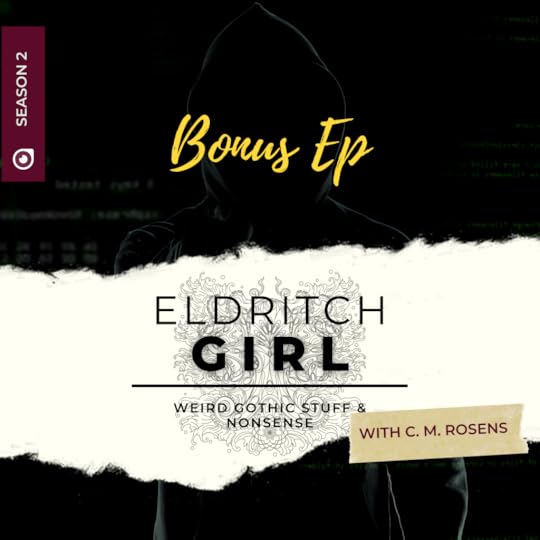
This month, the bonus episode is … the audio version of my short story OVEREXPOSURE. This is available for £1.99 from all ebook stores and is a prequel featuring Wes, Charlie and (briefly) Hugo. It’s the tragic start of their connection with each other, and you can grab a copy direct from my Ko-Fi Shop too if you want to support me directly.
Charlie Eversley-Smith is an affluent young photographer in London, and a sensitive, detail-orientated creative soul who has always seen the world in her own way. When she meets a man whose image resists memory, she has to take his photograph again and again and again… but when he realises the extent of her obsession, is it already too late?
CWs for psychological horror, body horror, self-degredation, self-mutilation and mental health deterioration.
OVEREXPOSURE: Story TrailerOctober 21, 2021
Podcast S02E03 ~ Thirteenth Part 3
Welcome back to Eldritch Girl. In this episode, the first two sections of Chapter 2: Lord of the Flies, Ricky has some explaining to do…
CWs: bird death and entrail reading, facing mortality
LISTEN NOW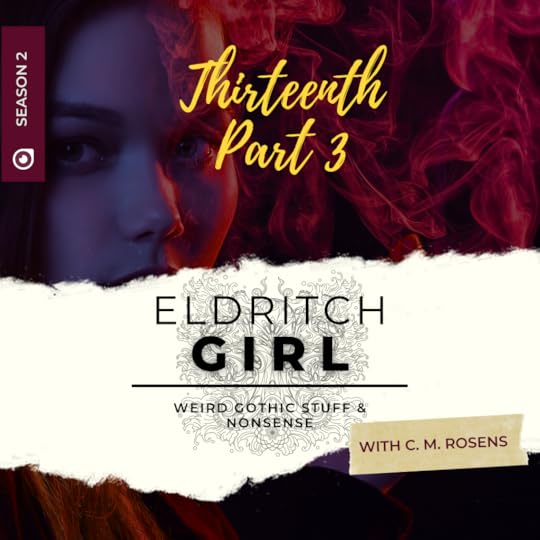 Chapter 2 ~ Lord of the Flies (1)
Chapter 2 ~ Lord of the Flies (1)Merlin Silvestris could prophesy accurately without reading the dead, he had read about it before. He’d thought that with his beauty now fully revealed, his glory fully manifested, that the secrets of the cosmos would fall into place before his eyes regardless of what form he was in.
~ C. M. Rosens, Thirteenth, Ch. 2 p. 46
Yet here he was, a few months on, and he was still rooting about in corpses and couldn’t see his own future. The forbidden desire hadn’t gone away, either. He tried not to think about it, but poking at the ruined bodies only made it starker, mocking him. He could see any number of things in his beautiful form, feed upon the energies of lesser things, open his third eye and bask in the wonders of what was yet to come… but he still couldn’t change it.
Ricky has a real thing about Merlin/Myrddin (hinted at in THE CROWS as well, where he briefly muses that speaking Welsh might make some ‘mad bearded old bastard’ show up), and this will get more explicit as we go on… He also Latinises/Anglicises Myrddin’s name because of his issues with the Welsh language (cf. THE CROWS: “That’s what you got for letting the Welsh move in, with power in their bloody poetry”). Ricky’s not a poet or a bard, not really, and he’s having to face a lot of his insecurities now that he’s not so sure of himself.
His main ones are around his relationship with his house, which he can’t control in the way he wants to. It was a bit of a challenge to figure out how the relationship with Carrie/Fairwood has developed over the past 8 months, but it was important to maintain that he has no sense of what “normal” looks like, and how they navigate the situations that arise one at a time. How this plays out as we go through this novel remains to be seen.
READ ALONGOctober 18, 2021
Book review: Thirteenth by C.M. Rosens
A great review from Meredith Debonnaire!!
Read it on : https://meredithdebonnaire.wordpress.com/2021/10/18/book-review-thirteenth-by-c-m-rosens/
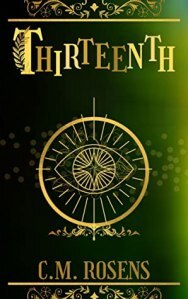 Gran’s house was the oasis of calm Katy Porter craved.
Gran’s house was the oasis of calm Katy Porter craved.
*note: Thirteenth is the sequel to The Crows, so you should read that first. Also this review may have spoilers for The Crows, so be aware.*
C.M. Rosens is in a league of her own, something I say with both love and enthusiasm. In The Crows, she grabbed every gothic horror trope she could find, put them through the blender, and somehow made me hate Carrie’s painfully mundane ex-boyfriend more than the literally-a-murderous-cannibal neighbour. In Thirteenth, she takes the idea of the Chosen One by the horns and then covers it in eldritch tentacles and teenage rage. It was an absolute joy to read.
Our protagonist is Katy Porter (she’s a cousin of Ricky Porter, a main character in The Crows who eats people and tells the future, yet I still want to just wrap him…
View original post 492 more words
October 16, 2021
Body Horror: Guest Post by April-Jane Rowan
Some of the books listed deal with taboos like necrophilia, have sensitive subject matter such as sexual assault, and are more extreme in terms of body horror, including experimentation on children/unborn children in a sadistic, cultish family, so proceed with caution!
Meet the Author and the Gurt Dog Press Team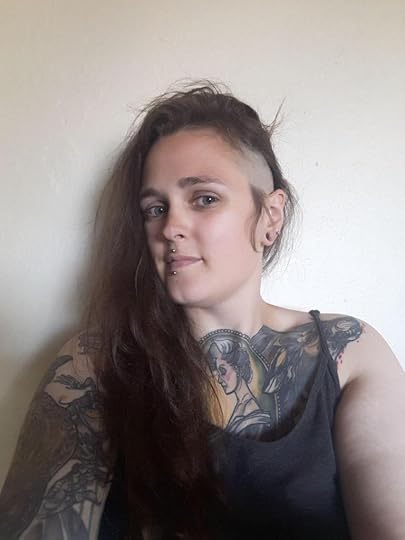 April-Jane Rowan
April-Jane Rowan
April-Jane Rowan was born with a morbid fascination that she turned into writing so she could explain away her strangeness. Luckily for her, she found she rather liked it, so for many years, she has been creating bizarre, dark tales. When not writing, she can be found lurking in graveyards, libraries and museums. She lives in Sweden with her two partners, Linn Sjölin and Nem Rowan, their triplets, and their pack of beasties.
They are the team behind Gurt Dog Press, currently in its third year of publishing LGBTQ+ SFF and Horror fiction, and B Proud PR, the sister company founded by Linn Sjölin, which is a promotion service for LGBTQ+ stories and authors.
Gurt Dog Press was started by Nem Rowan, an author of LGBTQ+ Fiction. His own work has been published by Less Than Three Press and JMS Books, but has now found a forever home at Gurt Dog. He is a transgender man from the UK, and he is especially keen to bring audiences to fellow trans writers in the Horror genre.
I was recently on C. M. Rosen’s podcast ‘Eldritch Girl’ where she asked me what some of my favourite Body Horror fiction was. Unsurprisingly my mind went utterly blank as it always does and I had forgotten to add favourite books to the notes I had scribbled just before the interview. The minute we had ended the call, I looked at my shelves and suddenly I could think of so many amazing books! I’m eternally cursed that way though, only thinking of what to say after the fact.
So this is my well thought out response, the one I should have given in the interview if my brain had worked fast enough, because these books are wonderful and need to be shared
The Beauty by Aliya WhiteleyThis novella starts strange and only gets stranger. It’s about a world where all women have died and all that is left is a bunch of lonely men trying to survive. They are soon joined by creatures made of fungi and it all takes a wild turn from there. This book is Body Horror at its most surreal and won’t fail to make you feel something, whether it’s disgust or confusion!
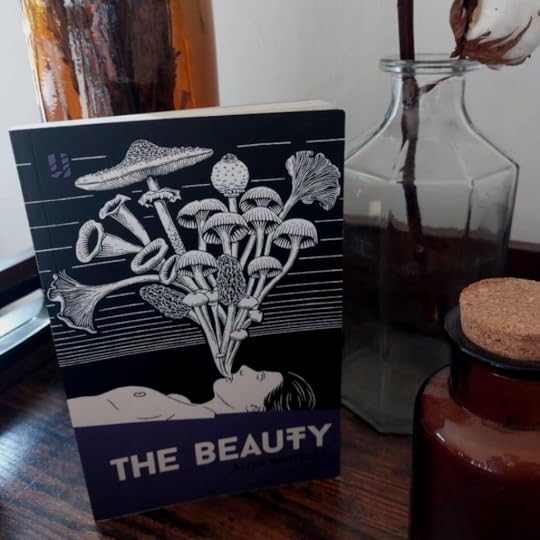 Her Body and Other Parties by Carmen Maria Machado
Her Body and Other Parties by Carmen Maria MachadoThis collection of stories weaves women’s experiences and Body Horror, creating something poignant and modern. Each one is a fairytale for this age and I have no doubt that this book will be dissected in classes in the future. My favourites were The Husband Stitch which is based off the tale The Green Ribbon, where a woman marries and her husband is always curious why she wears a green ribbon at her throat, and Difficult At Parties, which follows a young woman dealing with PTSD from being raped.
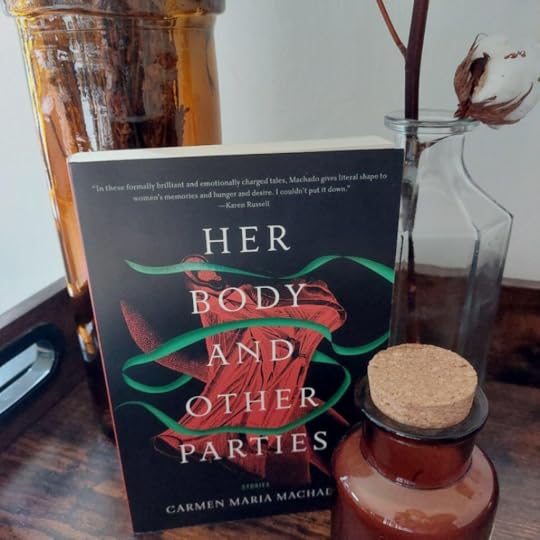 The Necrophiliac by Gabrielle Wittkop
The Necrophiliac by Gabrielle WittkopThis is probably the most polarizing on this list as the title can probably give you an inkling! It is very short, probably considered a novelette, and the story is told in diary entries. It is uncomfortable reading as the actions of Lucien, the Necrophiliac in question, are described in detail. What I love most about this compared to other books featuring this subject is that it is written as a love story. It doesn’t shy away from the aspects of death but it somehow manages to make you see it through Lucien eyes and I was left feeling very sorry for him and his failed romances.
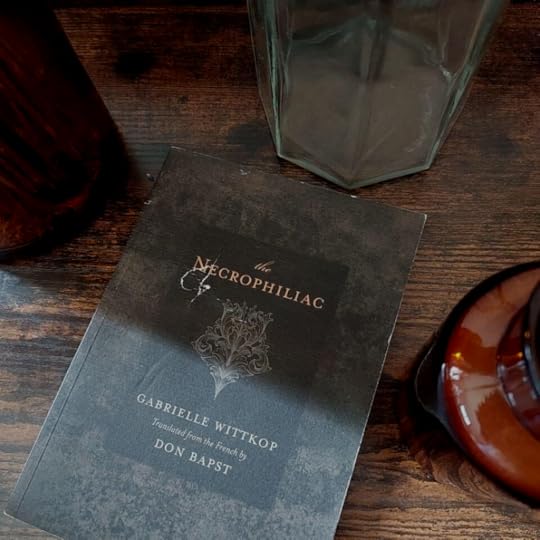 Geek Love by Katherine Dunn
Geek Love by Katherine DunnI often don’t see this on list of books featuring Body Horror, but what else could it be? A couple that meet as circus performers go on to breed their very own, experimenting with drugs and radiation so their children will be born with birth defects. It’s a family saga unlike any other! Despite not being described as a book about a cult, I think it perfectly illustrates that type of mindset and the terrible fallout from such behaviour. This one is Body Horror at its most unashamed and brash. In fact, I can’t think of a messed up and taboo thing doesn’t happen in this book!
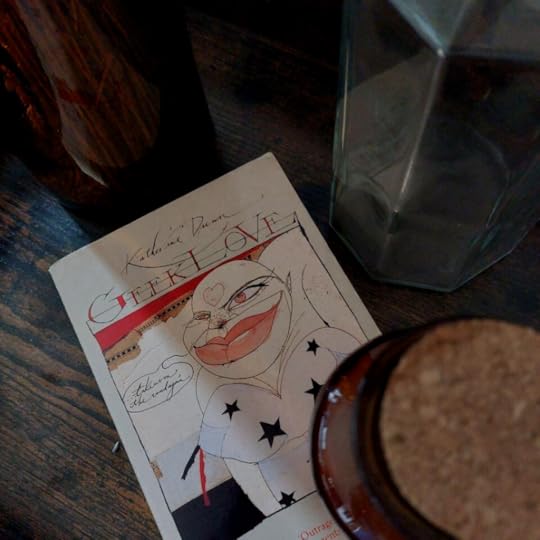 Bunny by Mona Awad
Bunny by Mona AwadThis is one of my recent favourite books and once I had finished it, I had the strong desire to just start reading it all over again. That doesn’t happen often to me! The book follows Samantha as she struggles with her creative writing course at university. What she struggles with the most however is the elite clique of women in her class that all refer to themselves as Bunny. What follows is a surreal tumble down the rabbit hole as she finds herself getting mixed up with this group in more ways than one. This book is just so clever! The prose and metaphors are just so well thought out and every inch of it drips with sarcasm. It’s perfect for people that love Body Horror which is Dark Acadamia.
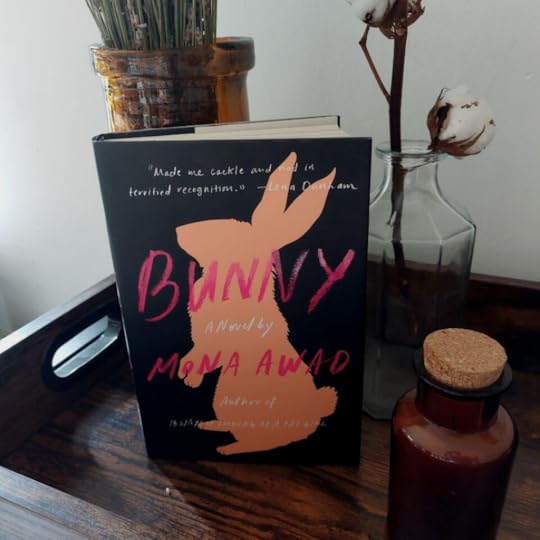 Beneath the Dead Oak Tree by Emily Carroll
Beneath the Dead Oak Tree by Emily CarrollThis tiny little zine tells the story of a fox woman and her lover that is hiding more than a few secrets. It’s deliciously gory and told in verse. Emily Carroll is a master at Body Horror comics, her bold art and spooky stories a perfect marriage. This zine uses a bright limited colour palette to offset the dark story and honestly I just want to frame every page.
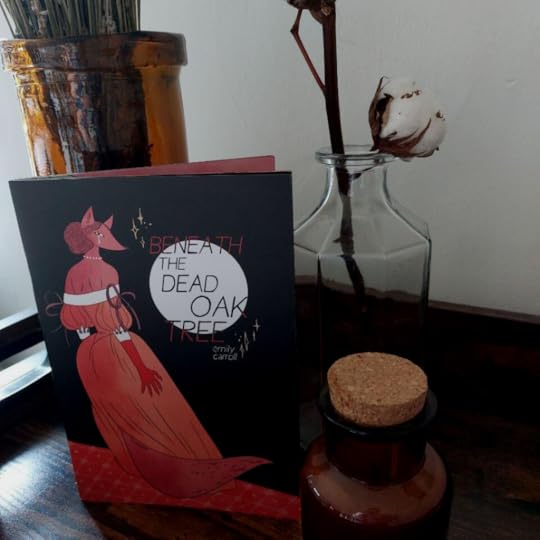
Thanks for reading and I hope you found some books to add to your TBR here! I have also authored two books that feature Body Horror, so if you are interested, you can check them out here – https://gurtdogpress.com/april-jane-rowan/
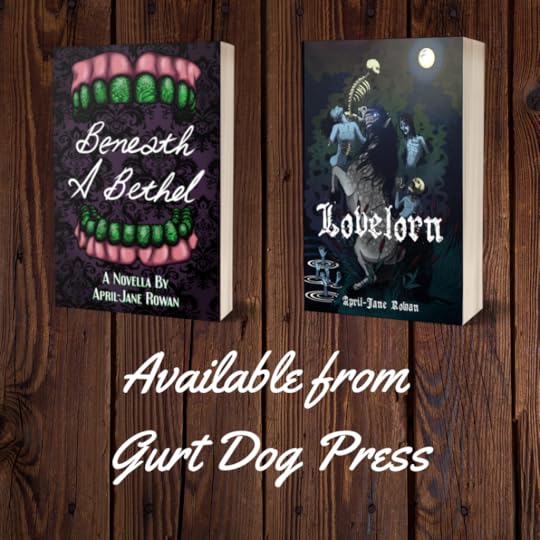
October 14, 2021
Podcast S02E02 ~ Thirteenth Part 2
Welcome back to ELDRITCH GIRL! This time, I’m having to split up the novel differently. THE CROWS had 21 chapters and an epilogue which worked out at around 23 episodes for the first season, but THIRTEENTH only has 13 chapters and is about the same length. So we’re going with calling the episodes “Parts” and splitting the chapters up by POV section.
Part 1 (S02E01) is the introduction to the novel, showcasing the new theme tune by Gemma Cartmell, and gives the content/trigger warnings for the book. It also has the Prologue which overlaps with THE CROWS’ timeline, telling events of the 14th May from a different POV. You can catch up with that episode here (the post) and here (the podcast episode).
LISTEN NOW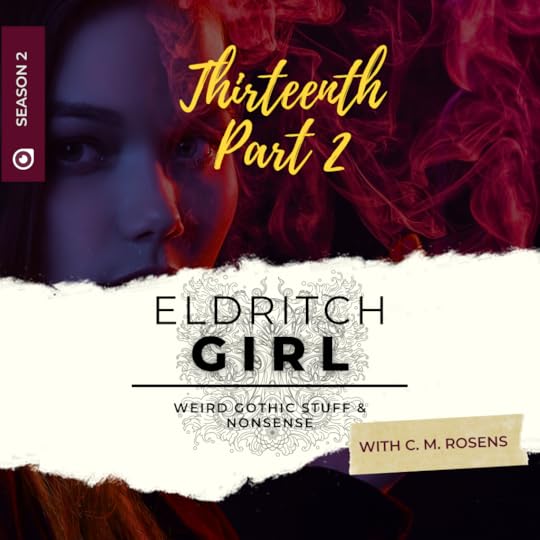
CWs:
Chapter 1 Part 1: Forced abduction of a minor by a family member (no SA); serial killer father intent on homicide of daughter (some readers might potentially read this as coded SA, but that’s not the story/intent).
Chapter 1 Part 2: Sibling trauma, abusive/toxic family dynamics, drugs and drug use (coerced)
Katy is abducted and Wes breaks several promises – but it’s not entirely his fault.
Katy flashed a look down the track, stretching into darkness, and back to the board. There was no sign of the train. It was still showing as delayed. The gate was open, barriers unmanned, the café on the other side closed up. She was still the only passenger waiting on the platform.
Cameras. Where were the cameras? There must be some.
Katy swallowed, dragging her case a little further down the platform and into the pool of light, where the CCTV hung below the lamp.
Her cousin let her retreat the few yards, shaking his head. “They don’t work, you know. Haven’t for weeks.”
Katy glanced across the platform to see if the train to Hastings was on time.
“Don’t do it,” he warned lightly.
She’d have to leave the case with all her stuff, her chargers, her hair straighteners, laptop, clothes, favourite pillow… Her fingers twitched involuntarily on the handle. She tried to move the handbag strap over her head to secure it if she had to jump down onto the tracks and drag herself up the other side. But then what? He’d follow. Could she do it as the train was coming, would she make it in time? Would it be going slow enough? Could she jump on before he got there? “You won’t make it,” he said, with enough casual certainty to spike her gut with doubt.
~ C. M. Rosens, Thirteenth, Ch 1, pp. 16-17
In this chapter we’re reintroduced to Wes who appeared in THE CROWS Chapter 16: Sinister Local History, where it was established that he:
(1) cannot be remembered when you look away from him
(2) deals drugs or used to, and certainly has easy access to them
(3) owns a house in an upmarket part of Pagham-on-Sea
(4) has a girlfriend called Charlie who is bi, and with whom he has an open relationship
(5) is a bit of a player and is Friends-With-Benefits with his childhood friend Tina
Wes is Katy’s oldest brother and three months older than Ricky. They are both 29 in this novel, and Katy is 17.
Wes has moved more permanently to London – he’s got his own flat in Chelsea as well as the house in Pagham-on-Sea, but he is currently staying in his boyfriend’s penthouse apartment in Kensington. He’s still with Charlie, and they form a polyamorous V with Wes as the hinge partner (Charlie and Hugo are very good friends but Hugo is gay, and they are not dating each other).
You also meet Katy in more detail in the first section of this chapter after the events of the gory Prologue, and find out what the consequences of that whole mess are. There’s a lot going on. One of the most fun things for me about writing this is that you see Ricky Porter through the eyes of two people who are blood-relations to him, and really don’t like him. These perspectives – a traumatised 17yo in survival mode and a drug-addled playboy torn between his lifestyle and his family responsibilities – are what shift the vibes of the book from modern Gothic Horror to far more contemporary weird territory.
Hopefully they are perspectives you’ll want to stick with!
READ ALONGOctober 11, 2021
Author Interview Transcript: S. T. [Saint] Gibson
In this episode of the podcast, I got to chat to S. T. / Saint Gibson, author of A DOWRY OF BLOOD. The interview discusses the themes of DOWRY, the novel DRACULA and its various adaptations, including the infanticidal nature of the brides in those versions, and may contain spoilers for films like Van Helsing (1992).
Author Bio
S. T. Gibson is an author represented by Tara Gilbert of the Jennifer De Chiara literary agency, and a literary agent and subsidiary rights manager for Spielburg Literary Agency.
Saint Gibson was born in California and raised in the deep South before moving up to moody New England. Prior to joining Speilburg, she worked as an assistant acquisitions editor at Tantor Media and as a ghostwriter of contemporary romance novels. She holds a bachelor’s degree in Creative Writing from The University of North Carolina at Asheville, and a master’s degree in Theological Studies from Princeton Theological Seminary.
Connect with Saint via:
Website: stgibson.com
Instagram: stgibsonauthor
Twitter: s_t_gibson
Newsletter: saint.substack.com
CMR: So welcome back to Eldritch Girl, and today I have Saint Gibson with me. I apologise for my very scratchy voice…
STG: That’s ok!
CMR: I’m getting over a very bad cold, so. It’s not – it’s not the plague.
STG: It’s not the plague, thank goodness it’s not the plague.
[laughter]
CMR: Hi Saint, would you like to introduce yourself?
STG: Hi, yeah, my name is Saint, I am an author of Gothic romance and fantasy, I currently live in Boston with my fiancé and my spoiled Persian cat and I’m also a tarot reader, and my book, A DOWRY OF BLOOD is a dark and dreamy Dracula’s Brides retelling that’s been out since about January or February of this year (2021), so about six months.
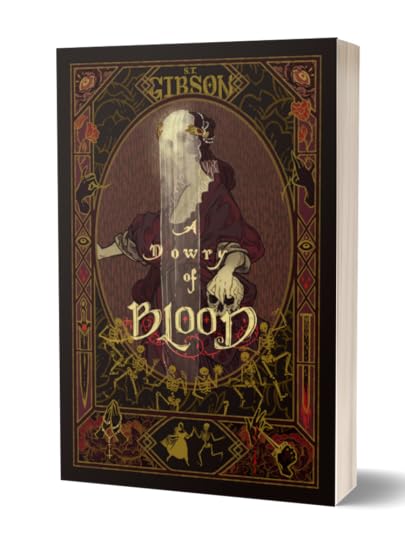 A Dowry of Blood by S. T. Gibson (Nyx Publishing, 2021)
A Dowry of Blood by S. T. Gibson (Nyx Publishing, 2021)CMR: Amazing. And I think you’re going to read an extract for us.
STG: Yeah, I am! I’m excited, absolutely. So a little bit of context: DOWRY is narrated by Dracula’s first wife, and so the “you” that she’s referring to in the first couple sentences of this, the man she’s talking to, is Dracula. And she is meeting another woman who Dracula’s trying to make his second bride and that’s where we pick up the story.
CMR: Brilliant. This is one of my favourite parts.
STG: Yeah? It’s the ballroom scene.
CMR: Yeah, I love it! Sorry. Continue!
STG: Thank you! No, it makes me happy.
Extract from A DOWRY OF BLOOD by S. T. GibsonI found you among the crowd, looking handsome and impassable in your black doublet and jerkin trimmed with gold. I sank into my place on your arm, suddenly feeling exhausted. The night had just begun, but I wanted to curl up and sleep it all away.
“You look lovely,” you said, smoothing your knuckle over my cheek as though nothing was wrong, as though Magdalena didn’t exist. For a moment, under the scorching weight of your unadulterated attention, I felt like I was the only person in the world.
Maybe it wouldn’t be terrible, a treacherous thought offered, to share you with another if you still looked at me like that when we were alone.
Magdalena was leading the dance, a prim and provincial series of turns and bows. She darted in between her partners, lightly brushing hands and shoulders in a complex series of touches. Every so often, her dark eyes flickered over to you.
“Dance with me,” you said, already leading me out onto the floor. I didn’t protest. I was happy to have something to do with myself instead of gape at the proceedings like a fish swimming through strange waters. I held your hand lightly and let you lead me through the first steps of the dance, quickly correcting my form by watching the gentry swirling around me. The world was a swirl of skirts and feathered hats, moving faster and faster as the musicians picked up speed.
Even surrounded by the flowering beauties of Spain, Magdalena’s loveliness was undeniable. She cut through the crowd like a shark darting through shallow waters, her teeth bared with laughter. She never missed a step, and never stayed with one partner for long. Every inch of her, from the soft curve of her cheek to the sharp line of her jaw, tormented me.
“Do you want her?” you asked, the words almost snatched away by the whirl of the crowd.
“What?”
We came back together, your hand a vice around mine. In the golden light of the hall, your eyes burned. I only ever saw that fire in your eyes when you were on the precipice of devouring something. It was all expectation and want.
“Do you want Magdalena for your own? To be your companion by day and warm your bed by night?”
Jealousy slithered up my throat as quick as a snake. But there was some other emotion mingled in, dark and sweet. Desire.
“Do you?” I asked, skirts snapping around my ankles as you twirled me. The whole world was turning, tilting on its axis.
“Ours is a solitary existence. It would be good for you to have a friend. A sister. I have never forbidden you from taking lovers, Constanta. Remember that.”
You made it sound like a gift, a gentle reminder of my own freedom. But I heard your double meaning: do not deny me this.
I opened my mouth but the words faltered. I didn’t know what I wanted. My heart, whipped into a frenzy by the wine and the dancing and the gleam of Magdalena’s dark eyes, felt torn in two directions.
I never got the chance to answer you. We were torn apart by the demands of the dance. I was sent spinning into another man’s arms while you crossed to Magdalena, slipping in beside her as close as her own shadow. No one could deny the light radiating from her face when she looked at you, like the halo of gold on a holy icon. Her cheeks were flushed pink from the vigorous dance, tantalizing proof of the hot lifeblood pulsing just beneath the surface of her skin.
How can I blame you for wanting her, my lord, when I wanted her so badly myself?
I strained to see over the shoulder of my partner as he turned me in dizzying circles. Older than me, handsome, with a healthy tan on his brown skin that told me his blood would taste like ripening summer apricots and the dust of a well-travelled road. I barely saw him, barely registered the appreciative smile on his face.
All I saw were you and Magdalena, two lovely devils indulging in a little human revelry. Your hand fit perfectly into the curve of her back. Her elegant, sloping neck invited admiration as though she already knew what you were, as though she were teasing you.
You lowered your mouth down by her ear, lips brushing the lobe as you spoke, something private and urgent. A slow smile spread onto Magdalena’s face as she clutched you closer. What were you telling her? Our secret? Or a more carnal proposition?
My feet faltered over the demanding steps of the dance, and I broke the tight circle of my partner and I’s bodies. He tried to coax me back, the cadence of his Spanish insisting that there was nothing to be embarrassed about, that we should try again. But I brushed him off, took a few staggering steps further onto the dancefloor. The couples whirled past me like exotic birds winging by in a flurry of feathers, and my stomach clenched. I like I was slipping out of my own body and floating above it, observing myself as a spectacle.
Then there was a small touch on my arm and I turned to see Magdalena, smiling that wry smile at me with her hair coming loose from its elaborate styling. There was a bloom across her chest, a slight sheen of sweat gleaming at her hairline. She looked like she had just stepped out of an opium dream, all blown pupils and reddened mouth.
“Your excellency,” I breathed, my heart suddenly in my mouth. “You will forgive me. I do not know the steps of this dance.”
Moving with shameless deliberateness, Magdalena cupped my jaw in her hand and kissed me full on the mouth. Not the light touch of a friend’s kiss catching the corner of my lips, but a kiss full of intention and warmth. My head swam as though I had just emptied a whole glass of wine, the entire frantic room falling away. It only lasted an instant, but by the time she pulled away, I was completely inebriated.
“Then I shall teach you,” she proclaimed, and took my hands in her own. “Do you want to lead? Or shall I?”
I stammered foolishly, throwing my eyes wildly around the room.
Magdalena threw her head back and laughed, a beautiful wolf savoring the terror of a rabbit.
“Me, then. It’s as easy as breathing. One foot and then the other. And don’t overthink it.” We moved together across the floor, fluid and unified. If any of her subjects had seen the kiss, they hid their disapproval well, restraining themselves to gossiping behind spread fans. No one stared or reeled in shock, merely continued with their dancing and drinking, eyes politely averted. As well-trained as her servants, then. This must not have been the most scandalous behavior they had seen from Magdalena.
“You must never overthink any good and pleasurable thing,” Magdalena went on, her cheek almost pressed to mine as we twirled. The wine on her breath was sweet as blackcurrants. I wanted to taste it on her lips as much as I wanted to taste it in her veins. “We should never deny ourselves any pleasure in this life.”
I could almost hear you in those words. Had you coached her, I wondered? No, there hadn’t been enough time. Maybe she really was a soul after your own likeness.
We glided together until the song was done and then, out of breath and giggling from our exertion, then raised our hands in applause with the rest of the crowd. The musicians bowed, mopping sweat from their foreheads.
Magdalena tucked her arms though mine and led me with deliberate steps through the crowd, leaning over conspiratorially.
“You must sit with me tonight at dinner. I must have you close, Constanta. I want us to be the best of friends.”
~ A Dowry of Blood extract reproduced with permission of the author, S. T. Gibson (2021)
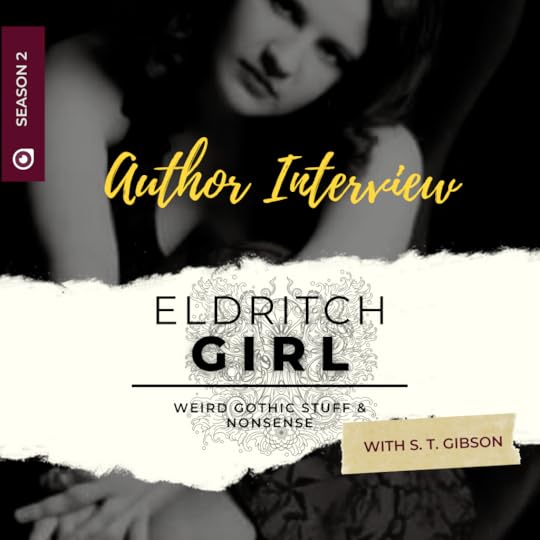 Interview Transcript
Interview TranscriptCMR: Oh, I love it.
STG: Thank you.
CMR: I love that. The whole premise of the book is so good, like it’s just such an interesting dynamic between them and it’s a really good character driven story.
And so, when did when did you first read DRACULA, which is the the source material for it, and which versions or adaptations of that were the most influential for you, when you developed DOWRY as an idea?
STG: Yeah so I first read DRACULA when I was in high school, I was probably about 15 or 16. We had to read it in my English literature class, and I remember liking FRANKENSTEIN way more than DRACULA.
DRACULA was not my favourite initially, but it really captured my imagination, because it’s such a strange book like just a lot of weird things happen and a lot of things aren’t totally explained, and you have these really compelling characters. I think that DRACULA is on one hand a cautionary tale about female sexuality and the “liberated woman” in a way, but it’s also has these really compelling female characters.
Like Mina is so strong in her own way and it’s really, really interesting, so I was definitely intrigued by Dracula, but I just became like a vampire enthusiast in high school and I still am like I call myself a vampire apologist. I got really into Anne Rice, who I still very much and admire… I admire her body of work and kind of the role that she plays in the literary canon. And I got into a lot of DRACULA adaptations, so I think that DOWRY is actually more a response to DRACULA in the pop culture imagination than it is a response to Bram Stoker.
There’s definitely Easter eggs about the book in DOWRY and it derives its inspiration from the Dracula mythos, but for me that was made a lot more of an impression on me through like the Coppola Dracula film (1992), and honestly the 2004 Van Helsing film.
CMR: YES.
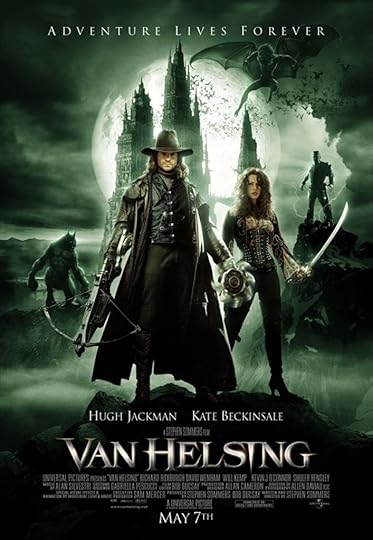
STG: If anyone has spoken to me they know that I love that movie it’s – if you haven’t seen it, the 2004 Van Helsing film is like a creature feature with like, Dracula, the brides, and werewolves and Frankenstein, that has Hugh Jackman in it, and it’s this like action adventure fantasy film. But I remember watching it when I was like 12, quite young I think, before I even read DRACULA. And you have these three like, just, gorgeous women who are so over-the-top dramatic and chewing the scenery, and they have this interesting dynamic with Dracula in the movie like, they kind of have their little lovers spats and they have this very passionate connection and it’s like a it’s a polyamorous harem you know, and I remember watching that when I was like 12 and being like, okay, I want to be in a poly vampire harem, like that sounds pretty good.
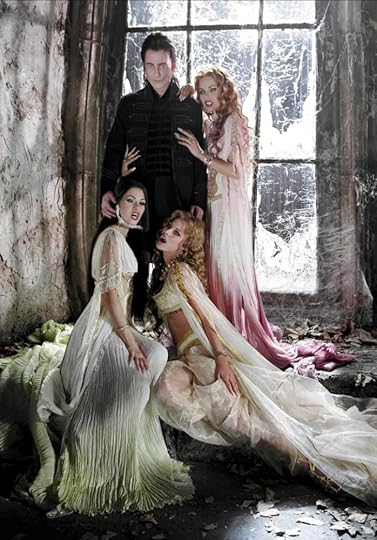 Richard Roxburgh as Dracula with the Brides: Aleera, played by Elena Anaya, Marishka played by Josie Maran, and Verona played by Silvia Colloca
Richard Roxburgh as Dracula with the Brides: Aleera, played by Elena Anaya, Marishka played by Josie Maran, and Verona played by Silvia CollocaSo I think that, like I said a lot of what a diary of blood is doing is responding to Dracula movies, is also responding to Dracula Untold (2014) which I don’t necessarily recommend, it’s not my favourite one, but I was really excited for it when it came out. And there’s a scene in Dracula Untold where there’s a close up on a dying village girl after there’s been a war, and I was like oh my God she’s going to be the bride, like he’s gonna he’s gonna turn her into a bride, and that’s not what movie went at all, but that’s what I decided to do with the book so that one frame inspired like, all of content.
So that’s just some of the inspirations and then there was many more like stage adaptations, the stage adaptation of Dracula, the Dracula musical and also musicals like Moulin Rouge and Elisabeth the German-language musical were huge influences as well.
CMR: Amazing. I love that Van Helsing film I watched it so many times.
STG: It’s my comfort watch, I just watched it last week again!
CMR: I love the Francis Ford Coppola version as well, I think it is so aesthetically beautiful. And Luke Evans did a really good job of Dracula Untold, I was really sad that they’re not going to do the Universal Studios monster reboot.
STG: I know! Me too!
CMR: It was such a good idea! I was like, oh no! And I think I know the frame that you mean.
STG: Yeah! No, it’s just kind of a lingering frame and I was like oh – this is where we meet the brides… it’s like he’s gonna take these women from his country and turn them into the brides and that didn’t happen, he was in love with his, you know about his wife, which was a beautiful love story, it’s very touching, but I thought I was going to get the vampire brides and I’m all about the brides. I’ve been on the brides’ side since I was 12 years old watching Van Helsing like I get so sad when they die every time.
CMR: Yeah, absolutely. I think it’s interesting when you have something that so obviously like a polyamorous dynamic and then some adaptations go no we’re not going to deal with that we want to focus on that the you know, Mina as reincarnated wife.
STG: Yeah, exactly.
CMR: That sort of… so it’s that One True Love dynamic…
STG: Right.
CMR: …which is a really lovely trope.
STG: No, I love that trope and it’s such a classic of vampire movies and vampire literature, but I do find it interesting how in a lot of the adaptations – and I think this is why the Van Helsing one is so compelling to me – in a lot of the adaptations, we do meet the brides and they get their awesome introduction and they’re always stunningly beautiful and like, fangs and blood and it’s this great vampire moment… But they don’t often interact with Dracula very much. They don’t really interact with Dracula very much in the Coppola adaptation. They don’t really interact with Dracula very much in the stage musical. Like they might have a couple of lines with one another, but it kind of is like he just he’s like, of course, I have a harem, I’m like here’s my harem, I’m like… I’m a villain.
But in the Van Helsing movie they have all this banter and they like kind of go back and forth and have like lovers quarrels and embrace each other and actually seem like they’re in a relationship, and that was so compelling to me when I was when I was young. It’s very campy it’s very over the top. But there’s some genuine moments of connection there that I was just really intrigued by and I wanted them to write an entire book that was just about the brides’ intimate relationships with each other and with Dracula.
CMR: I’m trying to think of any other adaptations that do that as well and I don’t think there is like, and I was thinking about the Hammer Horror franchise with Christopher Lee who ends up with – he doesn’t have – he tends to only have one bride a time in those. And then he goes after the village girls, but they again like there’s still like The Vampire Girl, there’s not like – they didn’t give him a whole host of vampire bride-girls. Even in the Hammer adaptation of DRACULA – ostensibly of DRACULA, which was a very loose adaptation, he still only had that one bride, and she only existed for the Harker figure to try and rescue her and fail. And that was like, the whole point.
And so the brides tend to get reduced to – I think a lot of adaptations, the brides get reduced to either these caricatures of the damsel in distress you can’t rescue, and that’s an inverted thing where the hero tries to rescue them but ends up in danger because it’s like a honey-trap thing…
STG: Exactly.
CMR: Or they’re just very decorative, and they’re very sad. Like in the Bela Lugosi version, the three are dressed in those diaphanous nightgowns, and you’ve got them coming in through the French windows and there’s, for some reason… Oh, because of the censors isn’t it, you couldn’t have rats so they had possums all over the castle instead. Have you seen this version, the 1931?
STG: No I have not.
CMR: The 1931 is an absolutely beautiful film, black and white, and they couldn’t show… they were doing things with cameras that that you couldn’t do you know, nobody had ever done before, so you have walking through a cobweb that is stretched all the way across the stairwell just because they could, so the cobweb remains intact, because they used magical camera trickery. [laughs]
STG: Oh, that’s so cool.
CMR: And they weren’t allowed, because of the censors, to show blood and they weren’t allowed to show fangs, and they weren’t allowed to show rats…
STG: That’s very essential to a DRACULA interpretation!
CMR: There’s this close-up on his mouth, just before he opens his mouth, and it’s the anticipation, and then it fades to black. And it’s done so well. And you know exactly what’s going to happen because everybody knows that Dracula is a vampire, so you can imagine that. But yes, so they had the brides in opaque nightwear, obviously, because of censorship, but sort of floor length and with the ruffles up to their necks and they still managed to look incredibly sensuous, but they don’t have any lines.
STG: Well the brides often don’t speak. I think they’re kind of – I think the brides are this institution from film-making, when you make a DRACULA adaptation, you feel like you have to have the brides. Even in campy ones like Dracula 2000 [also titled Dracula 2001, a Wes Craven film version] you do have some brides and I guess they do have some lines in that, but they don’t play a huge part. But I think, part of potentially what happens in adaptations is like – and this, I think, is in the text as well – there’s this Madonna/Whore complex almost, where the brides are like hypersexualized devious women that are frightening and scary, and then you have the more – the honourable Victorian human woman who is being tempted with sexuality and who is trying to fight off the vampirism which is more sexual and more embodied, but the brides are always just like these really sensual creatures and that might be part of the reason why they have not been totally fleshed out sometimes, because it’s easier to make them sexy window-dressing.
CMR: Which is interesting, because in the book, they’re the inversions of motherhood, because they eat babies.
STG: They eat babies, yeah exactly.
CMR: They literally eat babies, and that’s exactly what happens to Lucy instead of becoming the archetypical wife and mother, which is her projected pathway after she’s chosen one of her suitors, because she has three suitors – Lucy’s always struck me as the female version of Dracula, because she also-
STG: -ALSO HAS THREE SUITORS, EXACTLY-
CMR: and she’s just like, “oh I wish I could marry all of them, oh how scandalous” and nobody’s played with that in adaptations either.
STG: No.
CMR: I think Francis Ford Coppola does in that version but generally a lot of the adaptations ignore that part of Lucy, and try to make her… or, in the ’31 version, she’s, she’s kind of a flapper.
STG: Oh, interesting.
CMR: Yeah and she’s got the short bobbed blonde hair, very short cut, whereas Mina is a bit more conservative, and wears more conservative evening dresses. Whereas Lucy is coded kind of as a Good Time Girl, kind of, but affluent. But it’s really interesting to look at the costume differences and that kind of thing, so that starts to do something with that. But then Lucy goes off and starts eating children.
STG: Mmhm, yeah, exactly. You have that terrifying shot in the Coppola version where she turns around in her vampiric wedding shroud and she’s holding the baby, you know, like the child.
CMR: Yeah. Yeah and I think that’s actually what I like about the Van Helsing version is that they aren’t – well, they are also baby eating monsters, but they want their own kids.
STG: It’s a vampire infertility story.
CMR: That’s the whole – I don’t think we’re spoiling the film, that is the premise of the film.
STG: Yeah, that’s the whole point of the film, they’re trying to have vampire babies.
CMR: Yeah.
STG: Which is this like, very – I can’t – people always, like, when they poke holes in vampire stories, they usually bring up issues of fertility or with marriage and children. But I don’t see a lot of movies that are like let’s build a mythos around this, and so in the Van Helsing movies the children – the vampire children – who are monstrous, because the vampires have sexy human forms and then monster forums, the vampire children are born dead they’re born undead, and Dracula’s trying to bring them to life using Frankenstein’s technology. There’s a lot going on this film.
CMR: There is a lot going on in this film.
STG: Like you said, it’s an inversion of the trope. It’s also they’re allowed – the brides in that movie, even though they have a relatively small part – are allowed to want things and are allowed to be sexy and scary but also we see them grieving when one of the brides dies, we see them grieving when they can’t get their children to come to life. We see them arguing with their spouse Dracula and trying to salvage their relationship, really. It’s a “marriage in trouble” story, which is one of my favourite tropes, is a marriage in trouble.
On Developing the Brides as CharactersCMR: So, how did you then start to develop each of the brides in terms of creating their personalities, when you were first fleshing out the ideas? I really like Alexi as well he’s one of my favourites…
STG: He’s a fan favourite.
CMR: Yeah oh he’s so sweet, I… I can’t choose between them really, like I go through phases of liking each like deciding which one I like best. So why did you choose to make Alexi one of the brides and you know, did you think about basing them around archetypes or… you know, that kind of thing?
STG: I was definitely working with archetypes when I went to create the brides. I think first of all, when I sat down to write this book, I was like you’re doing a Dracula book. And that felt like a really big undertaking and it felt like stepping into really big shoes, and so I was like don’t try to do everything. Don’t try to address every plot point just build it from the ground up the way you want to do it and just write the characters you want to write so it’s not like I freed myself from having to be like this is my take on vampires like totally this is everything I think and believe and how I would have written it like it’s not that. So that gave me a lot of freedom with the characters and I could build them from the ground up like there’s no – there’s no Mina figure there’s no Lucy figure, like they’re kind of my own creations, and so I worked with archetypes initially to do that, I think that, like, when I started out, Con[stanta]… [short pause] There’s three brides, Constanta, Magdalena and Alexi, in order of when Dracula acquires them, and Constanta the first bride is kind of a response to the Anne Rice vampires who are very existentially and religiously tormented. And I would read those books when I was younger and be like I really wish there was like a vampire that had this intense inner world and intense sense of like, existential and spiritual meaning that wasn’t just like, “I am a damned preacher and God hates me”.
Constanta has a very complicated relationship with existence and morality and God and she kind of lives in the grey areas, she isn’t like… she doesn’t, she doesn’t necessarily think she’s a bad person or a good person. She doesn’t necessarily… like she’s still very faithful person, even though she is not sure what she thinks about God and religion.
So she was kind of a response to that the the vampire that has existential angst. She was my response to that, and the way that I would have wanted to have a conversation with that trope.
Magdalena initially is just kind of like the beautiful sadist like she is this glittering gleaming noblewoman who can be very cruel and very firm when she needs to be, and she takes to be a vampire very well, and she doesn’t have the same moral hang-ups about killing that Constanta does. But there’s a lot of depth to her, so I really liked that archetype. She very much – I think Magdalena is the most classically a vampire bride. She’s gorgeous, she’s hyperfeminine, she’s got sharp teeth, she’s going to eat you, she’s going to love it, but I wanted to go deeper than just like the beautiful sadist trope and so she also has kind of a complex inner world.
She deals with depression and mania, and she doesn’t just kill for sport blindly, like she kind of – she and Constanta have their own feelings about murdering, basically. And so I wanted to have a bride that really was just that fun sexy scary vampire bride but who had a lot of depth and heart to her as well and felt like a real person.
And then Alexi is a play on Dorian Gray really, is what he is. There’s a quote at the beginning of the book where like Constanta listing the reasons why she thinks that Dracula kept all the brides around, and she says Magdalena for her brilliance, me for my perseverance, and Alexi for his loveliness.
So Alexi is just like this beautiful young man in love with life, so he’s the hedonist, he’s the Oscar Wilde character, he’s the Dorian Gray, in love with life, making friends with everyone, wants to have all the pleasure in the world, wants to live on and never die and party all the time, which is another vampire archetype you get in Lost Boys (1987) and things like that, so he was a response to that archetype.
So basically it’s like you have the institution of the Anne Rice vampire, the classical vampire bride, and then the Dorian Gray hedonist sort of figure. And I started there and then I explored them all and their interaction with one another and deepened the characters from there.
And so you asked about Alexi, who is a fan favourite… I love my boy. And I – that was just a whim, I was like I want one of the brides to be a guy. I knew when I sat down to write this that I wanted it to be incredibly bisexual. I wanted every character to be bisexual.
I wanted everyone to be in an intimate friendship, familial, erotic and romantic relationship with every other character, on their own terms, and it was just more interesting to me to introduce another man into the mix.
And I just – I love that kind of Dorian Gray kind of archetype of this beautiful young man who’s burning too bright at both ends and is in danger of burning out, and so I pulled that archetype and I kind of made that into Alexi.
On Time, Immortality and Relationship EvolutionCMR: Yeah I love – yeah I just love the different ways that the characters interact and that they –
STG: Thank you.
CMR: Yes, also over time, because the story takes place over a huge swathe of time.
STG: Yes.
CMR: How many centuries is it? It’s a couple of centuries isn’t it.
STG: It is. So we’re starting – like do not quote me on this guys, I did the research and then it all left my head, but I think we’re starting like 1300s like 1320, and then Magdalena is Early Renaissance and then Alexi is … There isn’t exactly I can’t remember but he’s the 20th century, and then we follow them or maybe that the tens, the teens of the 20th and we follow them through through about the 30s.
CMR: The 1930s.
STG: The 1930s, I think is when it ends. I mean the story goes on, but that’s when the book ends. So yeah it is it’s like hundreds and hundreds of years it’s quite a long time.
CMR: Yeah and I’m just thinking about the how you maintain believable dynamics and levels of change between those characters over that amount of time, I think you did it really effectively, because you didn’t try and show every little detail of every conversation that they had over hundreds of years, because that would have been impossible, but you did it really effectively in terms of just giving snapshots, which really worked well, I thought. I really enjoyed that. And you give that impression of racing through time at different speeds and I wanted to know how you found the process of keeping those dynamics developing in a believable way when you were dealing with that amount of time and how you feel like immortality plays in in in the way that they experience time and so on. I just wondered if you had thoughts about that.
STG: Yeah no that’s a wonderful kind of bundle of questions. I think, first of all I’m really interested in the way that relationships, especially romantic relationships, evolve over time and I think that people changing and the dynamic of your relationship changing is like a natural and healthy part of a long term relationship. But that is a very difficult thing for a lot of people to adapt to, I think a lot of times, we want the beloved to be the same beloved that they were when we met them.
But people grow and change and, if you want to be with someone for 20, 30, 40 years or eternity, you have to be comfortable with them being various different people during your time together and sometimes that results in a parting of the ways and sometimes it doesn’t. But it was a theme that was really on my mind a lot and I was like what would that be like, even if, like… it’s already an undertaking to spend your whole life with someone. What would it be like if your marriage is until the end of time, you know, what would come up and what would change?
And I think like the dynamics between the vampires do change like primarily if – I think everyone who is familiar with DOWRY knows this, but just like a general warning: A DOWRY OF BLOOD is about intimate partner abuse. Dracula is an abusive partner and it’s about the brides growing away from him and getting away from him.
Because, you have the decay of the relationships in the context of intimate partner abuse on the Dracula end, but you also have relationships that change and grow like constants and Alexi start out with having feelings for each other, but not really acting on that and being more of like having more of a familial relationship, and then the relationship becomes more romantic or sexual later on, as they grow and develop as characters and as Alexi becomes more mature and kind of has a more sense of himself outside of Dracula, so things like that happen.
I think something that I was really interested in exploring in this book that helped me make those decisions was how every vampire deals with immortality differently. And immortality in DOWRY is kind of a terrible thing, like the vampires do find their own happiness, but it really gets to you after a while. And like it exacerbates mental illness or it creates existential angst or it decays relationships… like there’s this idea that we’re not meant to live forever.
And you have to find your own way through to happiness, because if you don’t really try it’s going to consume you.
So all the vampires have things that they love about being immortal and things that are kind of trying to consume them and destroy them about being immortal. I think even Dracula – like he gets more possessive and more paranoid over time as it starts to weigh on him more and more, and in the beginning he’s not so bad, and then by the end they totally can’t live with him.
So that’s kind of the… various themes that were at play when I was making those decisions – does that answer your question?
CMR: Yes, it does, I think it’s really interesting because I think when you’re dealing with longevity and relationships like just a normal amount, a normal human amount of longevity… there so much in that, I think you’re so right because not only does your partner change, I mean, you change as well.
STG: Exactly.
CMR: So… you’re basically… you kind of have to just rediscover each other, and you have to keep rediscovering each other, and that’s…
STG: That’s beautiful. That’s exactly it.
CMR: Yeah, it’s either something that can keep you going, or, potentially – I mean you’re rediscovering yourself as much as you’re rediscovering your partner, and that’s something that can break you apart, because it’s… you’re not that person anymore, they are not that person anymore and you’re not the right people to be together at that point in your life, so yeah it’s a – it’s a double edged sword for sure.
STG: Yeah, yeah.
CMR: I can’t spoil how it ends, but I loved the short story sequel that you had in your newsletter.
STG: Oh thank you! I loved writing it, it was cleansing, it was healing for me! [laughs]
CMR: And it was it was just such a lovely – yes such a lovely kind of follow up to it and you got to see what happened afterwards. Yeah and I really like the – again I can’t say too much about the ending, that’s really annoying. I really liked how it ended, I can say that.
STG: Yeah!
CMR: It isn’t an easy ending and that’s also really good it’s not, I don’t want to say it’s not a happy ever after because it kind of is –
STG: It kind of is.
CMR: Yeah, it is.
STG: It might not pass for one in romance terms, but it’s – it’s – I would say it has a happy ending. It has a triumphant ending.
On Horrormance and Genre ExpectationsCMR: Yes. I’m trying to think of all these different versions of polyamorous relationships as represented in books and media and it’s really hard, actually, to think of…
STG: There’s not a lot, yeah.
CMR: I can think of a couple that are you know… There’s a French film, I think where there’s a triad, yeah you know what I mean? I can’t think of the title at all… and you can find things like that, where it’s kind of you know, working through jealousy and it gets very gritty and it gets very… um, it’s always got that that kind of sad realist kind of tone to it.
But when you’re writing very messy relationships, there’s not a lot of that, or there’s not a lot of variety in terms of the way that can play out. So I was just wondering, you know, in certain genres, especially in terms of genre expectations, it makes it a lot more difficult to explore darker themes like spousal abuse, like intimate partner abuse, you know, those sorts of issues within relationships, because it doesn’t lend itself to that Happy Ever After that people want to read in say, romance, or the lighter side of Speculative Fiction that people want to read, arguably.
So just wondering, you know, what makes Horror a good vehicle for exploring these kinds of dynamics, for you?
STG: So I’m glad you asked that question because marketing DOWRY is like walking a tightrope. I made a tweet about this the other day, but like it’s… explaining the book to other people and getting it to the right readers is this mix of being like, fun sexy vampire threesomes in Europe! Have a good time! …And this is a story about intimate partner abuse, please check the trigger warnings and read with care, like it deals with mental illness and despair and all this kind of stuff.
But I think that Horror and in particular the Gothic genre are the perfect home for stories like that. I was able to do – um, DOWRY is quite experimental and I was able to do a lot of things in this book, I think, because of the genre, that I couldn’t get away with at this point in my career if it was a traditional fantasy or a traditional romance. It’s queer and polyamorous which I will say is becoming more accepted, and people are starting to realize that there’s a really big market for that, but that’s still kind of odd to market.
It’s written in an experimental diary format, it has these dark themes, but I think Horror is such a welcoming home for being experimental and for digging into the darkness and to not shy away from it and not be afraid of it, and especially the Gothic genre, like, raised me, like Anne Rice, vampire movies, THE PHANTOM OF THE OPERA, like these are my formative… formative texts.
And that was a space where the beautiful and the horrifying, and the gruesome and the sublime and the ecstatic and terrifying are kind of necessitated to live hand in hand. And so it’s a really welcoming home for a story like A DOWRY OF BLOOD. And I’m really happy, I mean I’m very, very happy with the reader response. It’s been mind blowing. And I think that it has found the right readers because people… when you say, like a Gothic horror romance or a romantic fantasy with Gothic overtones they’re like “oh it’s Gothic”… there’s more willingness to be taken on a wild ride I think.
We talk a lot in the romance genre about building trust with readers, and not breaking that trust, and I think that in the Gothic genre people are a little more willing to have that trust bend but not break. Like to be like, “Okay, this is really wild, I wasn’t expecting this but I’m along for the ride, I’m going to trust this author to get me through to a satisfying ending”, and I think that I’ve had a really positive experience with that being situated in the Gothic genre.
CMR: I think that’s – yeah. I think again, the genre expectation is really key there, isn’t it, because you’ve got – I mean it’s written in an epistolary form.
STG: Yes.
CMR: So it’s very much like the original DRACULA in that respect, because it’s diaries and journal entries and people love the way it was set out as well, so you have in the paperback it’s fragments – not even full page prose sometimes, you just have fragments on a page, and then you move on to the next entry and the entries are various lengths.
And I really think that works, I like that very much and I think when you’re… if you’re familiar with Gothic horror or Gothic novels in general and the Gothic mode, like, I think you know that there’s probably going to be some… you, you can expect a romance potentially if that’s what you know…
STG: Yes.
CMR: But also people get walled up alive, do you know what I mean? [laughs] And so, you know, you’re also expecting gore, you’re expecting… there’s a whole host of very well-known Gothic tropes that pop up, that I think people are willing to expect, I mean up to and including things like sibling incest or on the more horrifying end, people being burned alive, people being walled up alive, the horrible endings and the tragedy of it, and so, when you have like a triumphant ending, even though quite a lot of blood has been spilled to get there, that’s that’s a big bonus, because people have bought into the – people buying into that genre and knowingly buying into something fairly horrific as much as they’re buying into the sexiness and the aesthetic of it, that decadent Gothic aesthetic, comes with that darker undertone that you can’t do without.
STG: There’s an Italian word that I’m going to mangle, that comes up in art theory, I believe it’s chiaroscuro, and it’s the juxtaposition of light and dark in a painting and how they bring out one another more starkly, and I think about that a lot when I think about my work, especially A DOWRY OF BLOOD. Because I think that the sweetness is all the more sweet for the pain and the the light spots in the hopeful parts are all the more hopeful, because the book is so dark. And they kind of bring each other into sharp relief and I think that that’s what the Gothic genre is all about, like that’s what it’s about.
CMR: Yes. I love that. That’s a really lovely note to end on, I think.
Future Projects[After this interview was conducted, Saint has been able to reveal that she is now employed by Spielburg Literary Agency as an agent, and she is at the time of this episode being aired open to queries. You can find her Manuscript Wish List here. If you think she is a good fit for you, you can pitch to her via her Query Manager, here.]
CMR: Do you have anything coming out that you would like to let us know about, or anything that you would like particularly like to plug while you’re here?
STG: I’ve got a lot cooking right now, but none of it is announced yet and a lot of it is still in the works and in revision, so I don’t have anything new to share with you guys just yet. But I will say, if you want to know all about what’s going on and also get information about my giveaways and events – I do lots of Live on Instagram with other authors and I give away signed copies and posters and things like that – follow my newsletter which is saint.substack.com, and you can also find me on Twitter at s_t_gibson, and on Instagram at stgibsonauthor, and that is where I live.
CMR: It’s very worth signing up for Saint’s newsletter, everyone. Very worth it.
STG: Thank you so much. Sometimes you get epilogues! To books that I wrote!
CMR: Very, very enjoyable. Well thank you for coming on the podcast, I’ve really enjoyed it.
STG: Thank you so much for having me, I really appreciated it, it’s always so much fun to be able to talk about vampires and the Gothic and all that kind of good stuff.
CMR: Well thank you very much again, and looking forward to seeing what you’ve got coming out next.
STG: Thank you so much. Yeah, have a wonderful evening.
October 7, 2021
Eldritch Girl S02E01 ~ It’s Back!
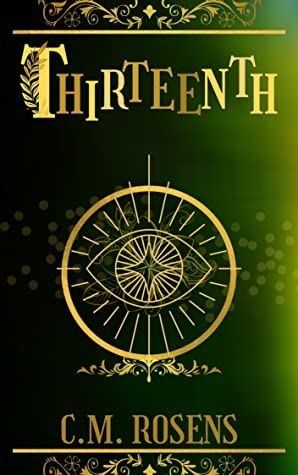
Today we’re kicking off with the first episode of a brand new season of ELDRITCH GIRL, in which we meet Katy Porter again – she pops up as a cameo at the end of Ch 4 of THE CROWS – this time from her point of view. She’s turned 17, and life is going downhill pretty fast.
Katy is another subversion of The Chosen One trope (I played with that in The Crows too: Carrie is arguably someone the house ‘chose’, although her fate is not … a great one … and Ricky is also a very twisted version of this, and I thought it would be fun to play with it much more explicitly).
Obviously, every great young hero starts off with a death, and Katy’s dad is a serial killer, so she’s already streets ahead there. The prologue kicks off with the events of 14 May, as read in the Epilogue of The Crows, so if you don’t already know what happened… you’re about to find out. As is Katy, staying overnight at Granny Wend’s cottage, when she takes her headphones off and ventures downstairs to discover what went down while she was blasting pop punk and trying to revise for her Chemistry A Levels.
The BlurbLovecraftian horror meets kitchen sink drama in this dry, darkly funny tale of toxic families, killers and cannibals, eldritch body horror and antihero female rage.
Katy Porter is the thirteenth child of a thirteenth child in an inbred family of eldritch horrors, and her own eventual metamorphosis will change her into a creature that hungers for her family’s flesh. To some, she’s a threat – to others, a weapon.
Katy needs allies to help her control her Changes, but she’s stuck with her oldest brother, a drug-addled playboy who voted to have her killed but is chaotic enough to have genuinely changed his mind, and her eyeball-eating, god-like cousin, whose idea of protecting her involves abduction, dark rituals, and encouraging her homicidal side.
If anyone is going to survive Katy’s transformation, scores need to be settled and fears need to be faced – and Katy is not the only one who needs to face them.
The Content Warnings, Potential Triggers, and General Advisory Notes:This is a book containing Weird Fiction and Gothic Horror tropes, dealing with familial trauma and generational abuse cycles, which explores the toxic dynamics inherent within an inbred family of eldritch horrors. There is a lot of violence but no sexual threat. Humour is used throughout by the characters themselves and can be found in their interactions with each other, but the topics in the book are not taken lightly, nor is it the intent to make light of them. This is a book for people who find dark humour cathartic, and/or enjoy bathetic family drama with tentacles.
There is a lot of recreational alcohol and drug use with a darker, and in one case coercive, undertone/context. There is no sex nor current sexual attraction between the blood-related main characters, but there is a complex history between two cousins. There is one on-page interrupted sex act [fellatio] between consenting adults in a long-term relationship. Two MCs are sex-positive and sexually active: an adult playboy (with enthusiastically consenting adults) and his teenage sister (with teenage boys her age). There is a central sexless but intimate queerplatonic relationship between two other adult characters, one of whom is on the asexual and aromantic spectrums and is uncomfortable with sex when it’s discussed.
The following list is advisory not comprehensive: I may have missed your particular trigger but take this as a general flavour of content and use your own discretion.
MENTAL/PHYISICAL HEALTH
-addiction, including addiction to a person in a literal sense
-altered reality, drug-taking and on-page trips by POV character
-some instances of depersonalisation, derealisation, questioning reality by POV character, who also has some incoherent thought patterns and memory issues relating to his drug use
-alcohol use/abuse/relapse by a male character inside his POV, involving a total lack of self-awareness
-issues with emotional disregulation
-disordered eating (male), binges and vomiting
-self-harm (teenage girl, makes reference to historic cutting but currently uses her own nails and bites her cheeks), self-destructive behaviour of adults
-a reference to gender dysphoria
-emesis (repeated, different characters, as a stress reaction and rotten food + drug trip reaction)
ABUSIVE/DISTURBING DYNAMICS
-abduction of a minor by family member (no sexual threat)
-toxic, dysfunctional inbred/incestuous (siblings/cousins) monster family, inc. bullying, boundary-crossing
-one partner literally addicted to another to the point that withdrawals cause self-harm
-adult male sexual arousal/fellatio (in context of dubious power dynamics in an m/f relationship)
-historic dubious consent/sexual harassment of asexual character with on-page memory depicted (m/m, first cousins, both teens)
-a homophobic serial killer father who targets teen girls, cold/emotionally neglectful mother
-NO CSA but historic child neglect and manipulation, emotional/psychological/physical abuse – character has positive memories and a complicated loyalty to their abuser, whose manipulation they didn’t see as ‘bad’ at the time.
HORROR TROPES
-violence and gore, violent deaths in an inbred eldritch familial context
-body horror [eldritch, mutation/transformational, parasitic/worm-adjacent]
-cannibalism
-very strong language throughout
-entrail-reading (birds), [wild] animal cruelty/death
Readers’ discretion is advised. CWs will be added to the start of each episode.
September 25, 2021
New Ricky Fan Art!
Check out artist Daniel Beswick if you like creepy Weird art! He messaged me on Instagram (where you can find him @/visceralrevolt) to say he’d picked up THE CROWS and he was enjoying it. I’ve been under the weather lately so I just had a nap and woke up to some AMAZING art of Ricky Porter, which cheered me right up.
View this post on InstagramA post shared by Daniel Beswick (@visceralrevolt)
Here’s the direct link to the video on Daniel’s Twitch stream of Ricky being drawn: https://www.twitch.tv/videos/1158053458 . This absolutely blows my mind that (at least one) person in the chat know who Ricky is, although I follow /skeletonotes (pronouns: e/em/eir) on Twitter and e has a Twitch channel too. You can check eir art out here: https://allmylinks.com/skelakit.
September 18, 2021
Book Trailer: The Reluctant Husband
I tried my hand at making a book trailer and it is my first proper attempt… it’s for my novella THE RELUCTANT HUSBAND which I posted about here.
Here is the YouTube link…
And here’s the Spotify Playlist!September 12, 2021
#AmReading: Fictional Murder
It’s spooky season, so I’m going to do a few posts on things to read during this time! Off the back of the non-fiction series of murder posts, I’m kicking off with murder at a haunted attraction, and then I’ve got a guest post to share with a load of recs for body horror books.
I’m co-writing a slasher romcom with Ezra Arndt, and as a result I’m watching a lot of slashers about snuff films and reading thrillers with murderous showmanship. Sasha is a burlesque performer who thinks murder is the next frontier of performance art, and her growing obsession with an erratic, mediocre hitman hired by her gangster uncle.
I’m reading a range of slashers as well as watching them, because enjoy a lot of the tropes. I’m relatively new to grindhouse and exploitation cinema and the slashers in general, but I’m really enjoying some of the premises and settings, and explorations of character.
One of the more recent books I’ve read – off the back of watching THE FUNHOUSE MASSACRE (2015) – is THE THICKET by Noelle West Ilhi.
Would you recognize a real scream on Halloween?
That’s the question haunting Norah Lewis.
She can’t shake the guilt that’s stalked her since the night her brother was murdered. She heard —and ignored—his last screams. Just like everyone else at the Thicket, a haunted attraction in tiny Declo, Idaho.
But as Halloween approaches, Norah’s personal tragedy is overshadowed by a media circus. Parents’ groups and PTAs lobby for a shutdown while thrill seekers far and wide clamor for a chance to visit the notorious haunted attraction.
Many of Norah’s classmates eagerly plan a visit. And, reluctantly, so does Norah, who is driven to retrace her brother’s last steps.
But the man in the grainy security footage whose masked face is plastered across the news hasn’t chosen the Thicket at random.
And, like Norah, he’s planning a return visit.
~ THE THICKET blurb
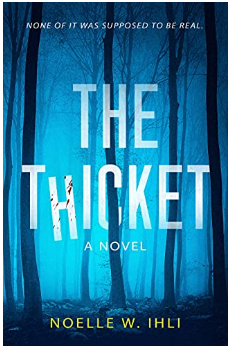
This book is a solid 3.5 for me, but I rounded up to 4 because I really did like the way the bereavement experience was handled, and the portrayal of messy younger MCs worked well in this context. I also found the characters sticking with me after I finished, and the vibes were what I wanted.
This felt to me like a mix of RIVERDALE meets THE FUNHOUSE MASSACRE, or maybe like it was inspired more the SCREAM Netflix series but there wasn’t quite enough depth in the exploration of the relationships and character arcs of the protags for it to quite live up to that for me. (SCREAM series has some issues, but it also has a really good character arc that is developed over the seasons and that I really enjoyed! You can’t really do that with a thriller novel in the same way, so that’s a bit of an unfair picky thing, I think.) The slasher villain is the Plague Doctor (that’s his mask) and he has a POV which helps the pacing, but again I was left with a lot of questions about him as a person rather than Evil Killer Who Likes Hunting. I did like the voice of the POV though.
The concept is fun – I like killers at haunted attractions (hence my FUNHOUSE MASSACRE comp) and there’s a corn maze scene too, which I always enjoy as a trope/setting.
If you’re looking for a slasher with a bit of teen angst and bite-size chapters, this one might work for you.
If you want to watch a comedy horror with more bite and aged-up protags, with a lot more gore and gratuitous everything, then THE FUNHOUSE MASSACRE has all that, and has the haunted attraction setting too…




